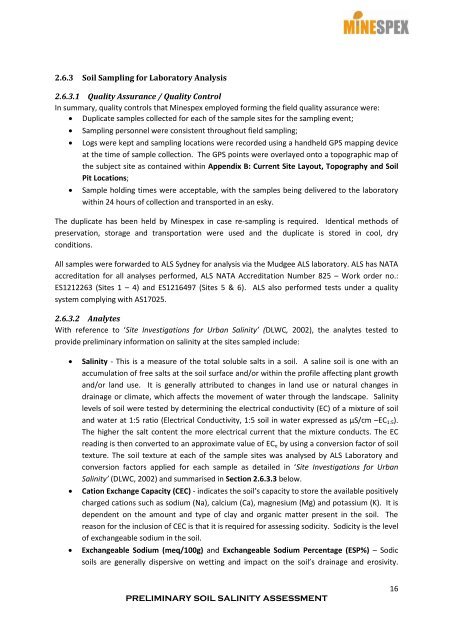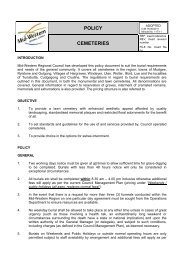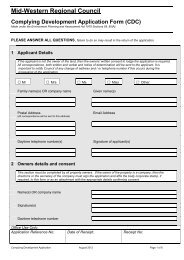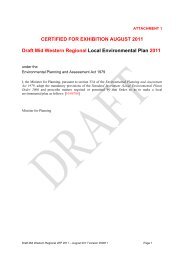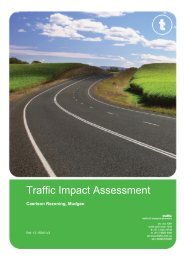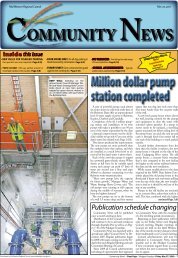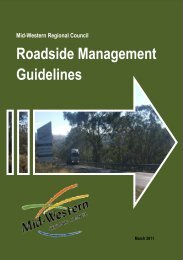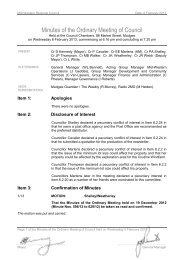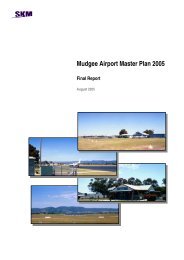preliminary soil salinity assessment - Mid Western Regional Council
preliminary soil salinity assessment - Mid Western Regional Council
preliminary soil salinity assessment - Mid Western Regional Council
Create successful ePaper yourself
Turn your PDF publications into a flip-book with our unique Google optimized e-Paper software.
2.6.3 Soil Sampling for Laboratory Analysis2.6.3.1 Quality Assurance / Quality ControlIn summary, quality controls that Minespex employed forming the field quality assurance were: Duplicate samples collected for each of the sample sites for the sampling event;Sampling personnel were consistent throughout field sampling;Logs were kept and sampling locations were recorded using a handheld GPS mapping deviceat the time of sample collection. The GPS points were overlayed onto a topographic map ofthe subject site as contained within Appendix B: Current Site Layout, Topography and SoilPit Locations;Sample holding times were acceptable, with the samples being delivered to the laboratorywithin 24 hours of collection and transported in an esky.The duplicate has been held by Minespex in case re-sampling is required. Identical methods ofpreservation, storage and transportation were used and the duplicate is stored in cool, dryconditions.All samples were forwarded to ALS Sydney for analysis via the Mudgee ALS laboratory. ALS has NATAaccreditation for all analyses performed, ALS NATA Accreditation Number 825 – Work order no.:ES1212263 (Sites 1 – 4) and ES1216497 (Sites 5 & 6). ALS also performed tests under a qualitysystem complying with AS17025.2.6.3.2 AnalytesWith reference to ‘Site Investigations for Urban Salinity’ (DLWC, 2002), the analytes tested toprovide <strong>preliminary</strong> information on <strong>salinity</strong> at the sites sampled include:Salinity - This is a measure of the total soluble salts in a <strong>soil</strong>. A saline <strong>soil</strong> is one with anaccumulation of free salts at the <strong>soil</strong> surface and/or within the profile affecting plant growthand/or land use. It is generally attributed to changes in land use or natural changes indrainage or climate, which affects the movement of water through the landscape. Salinitylevels of <strong>soil</strong> were tested by determining the electrical conductivity (EC) of a mixture of <strong>soil</strong>and water at 1:5 ratio (Electrical Conductivity, 1:5 <strong>soil</strong> in water expressed as µS/cm –EC 1:5 ).The higher the salt content the more electrical current that the mixture conducts. The ECreading is then converted to an approximate value of EC e by using a conversion factor of <strong>soil</strong>texture. The <strong>soil</strong> texture at each of the sample sites was analysed by ALS Laboratory andconversion factors applied for each sample as detailed in ‘Site Investigations for UrbanSalinity’ (DLWC, 2002) and summarised in Section 2.6.3.3 below.Cation Exchange Capacity (CEC) - indicates the <strong>soil</strong>’s capacity to store the available positivelycharged cations such as sodium (Na), calcium (Ca), magnesium (Mg) and potassium (K). It isdependent on the amount and type of clay and organic matter present in the <strong>soil</strong>. Thereason for the inclusion of CEC is that it is required for assessing sodicity. Sodicity is the levelof exchangeable sodium in the <strong>soil</strong>.Exchangeable Sodium (meq/100g) and Exchangeable Sodium Percentage (ESP%) – Sodic<strong>soil</strong>s are generally dispersive on wetting and impact on the <strong>soil</strong>’s drainage and erosivity.PRELIMINARY SOIL SALINITY ASSESSMENT16


